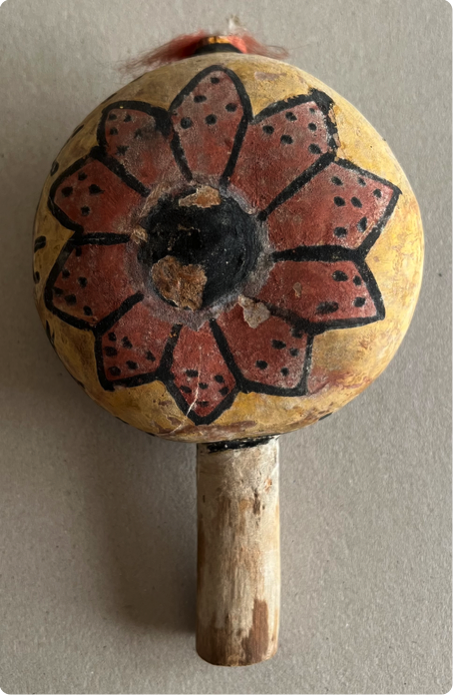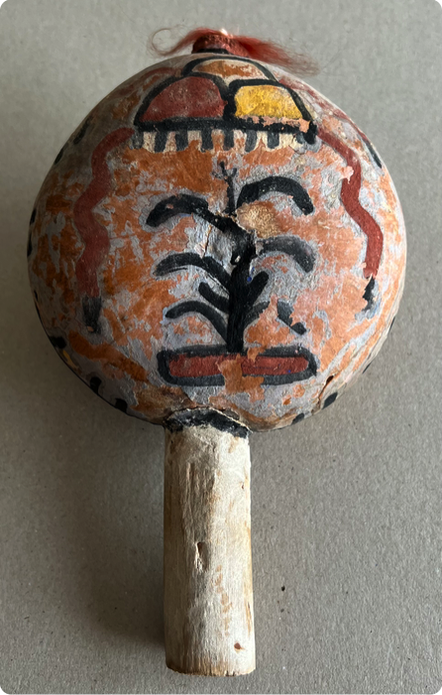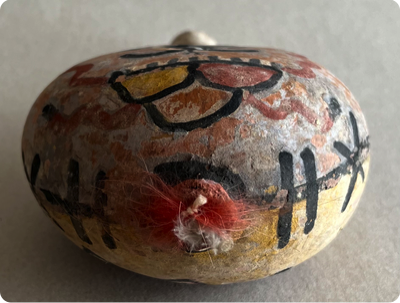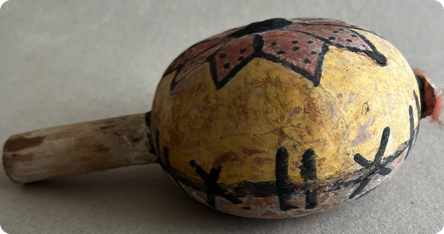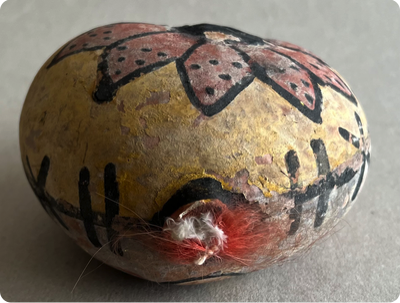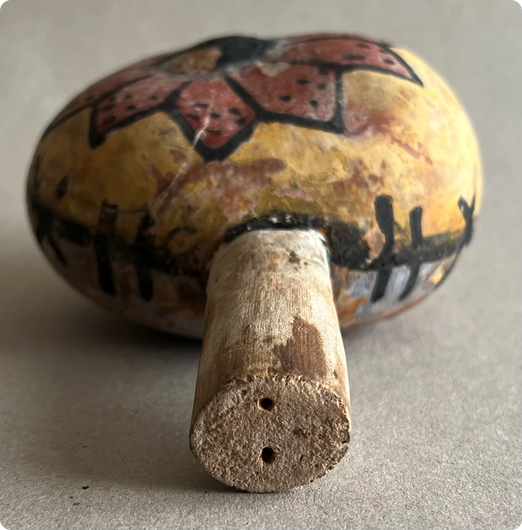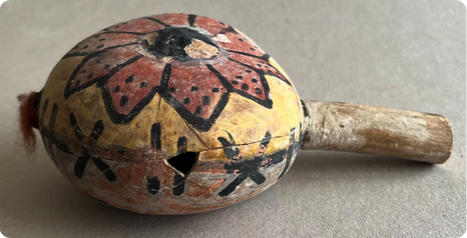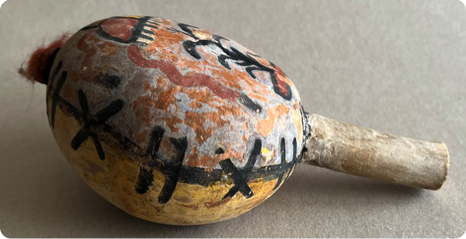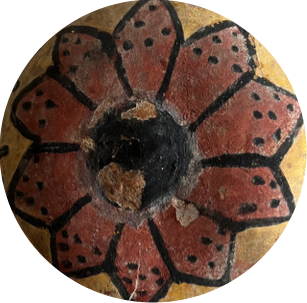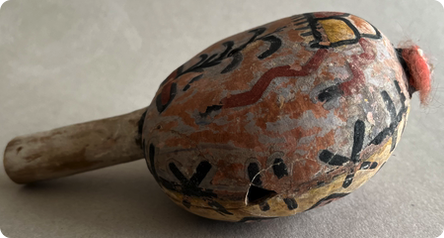
© 2010-2025 by Fine Arts of the Southwest, Inc. All rights reserved.
Unauthorized reproduction or use is strictly prohibited by law.
A rare historic Hopi painted gourd rattle
by Wilson Tawaquaptewa, c.1930’s-40's
The historic Hopi Village Chief, Tawaquaptewa, or “Sun In The Sky”, (A.K.A. Wilson Fredericks,1873-1960) was one of the most fascinating and enigmatic figures in modern Southwestern history. He was the hereditary Bear Clan Leader who, for an unprecedented 54 years, served as “Kikmongwi” or Village Chief of the ancient Hopi village of Old Oraibi on the Hopi Third Mesa who led his people during an extremely turbulent time in modern Hopi and American history.
In later decades, from around 1920 to his death in 1960, he also found considerable renown and prestige as an outstanding folk artist carver of his own unique personal style of Kachina dolls and dance rattles as well as more secular figures and effigies. Tawaqupatewa’s brother, Charles Fredericks and his Nephew, Oswald “White Bear” Fredericks also became renowned, but much more traditionally oriented Hopi Kachina carvers.
At left, Chief Tawaquaptewa painting a Kachina doll outside his home in Old Oraibi, c. 1950's. At right, a view of Old Oraibi Village, 1899.
Left photo source and © Pinterest. Right photo source and © Wikipedia.
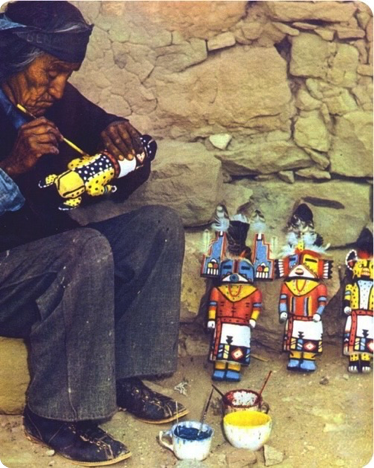
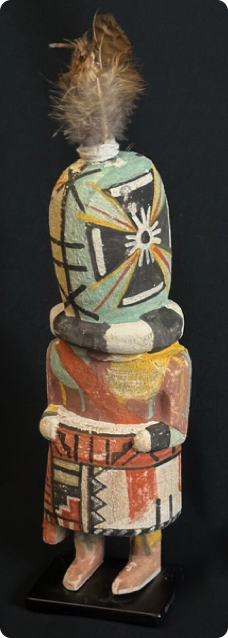
The rattle measures 8" in height and it is 5" in width at its widest point and 3” in depth at its deepest point. It is in generally good original condition, especially considering its fragility and its 80-90 or so years of age, but it does have a considerable amount of wear and some small amount of damage. There is a small, approximately 1/2" hole in the gourd on one side from which the tiny stones or seeds that originally made the rattle sound have escaped so the rattle doesn’t “rattle” any more but that’s not why you’re buying it. There are also some cracks around this small hole which appear to have old glue repair and there is some paint flaking and some paint loss around the rattle’s surface. It appears from this amount and pattern of wear that unlike many of Tawaquaptewa’s rattles which were usually sold to outside Anglo tourists, Museums and collectors, that this particular rattle might have very possibly seen some real ethnographic usage in Hopi dances. It has definitely had a life and has emerged basically intact but with a few battle scars to show for it.
All in all, this rattle is a rare, beautiful and unique old Hopi art work with wonderful distinctive and beautiful Hopi designs, great old paint and loads of character and patina by one of the finest, most original and most desired of all 20th Century Native American artists, an individual who was also an extremely significant, powerful and profound figure in Hopi and Southwestern American history.
Price $1,375
Today, Tawaquaptewa’s uniquely distinctive wood carvings and rattles are always very highly-prized and very eagerly sought after by collectors around the country and the world. They always have an immediately recognizable and highly distinctive color palette and muted but colorful appearance; unique Hopi designs painted with thick black and often blue and brown and distinctive deep yellow mineral pigments and, often an unusual pattern of small black dots and small attached pieces of red cloth material. Tawaquaptewa’s dolls and rattles are never “accurate” to the exact traditional form and design details, they are always stylized or altered in some ways since Tawaquaptewa firmly believed that his important religious position as Kikmongwi and Bear Clan Chief prohibited him from producing completely accurate depictions of the sacred Kachinas and dance paraphernalia for sale.
This rattle features two different painted designs, one on each side. The first side’s design is a typical Tawaquaptewa stylized depiction of Hopi clouds, lightning and falling rain above a Hopi corn plant done in red, yellow, blue, black and kaolin white paints. The second side features another completely typical Tawaquaptewa painted design of a large large flower done in dusky red and black paint against a yellow painted background. Both painted designs indicate the supreme importance to the Hopi of rain and fertility of the earth and success at growing things. All the way around the sides of the rattle’s gourd are painted crosshatched border designs rendered in a thick black mineral paint. In a very subtle touch, these crosshatched black border designs are stylized versions of the designs found on the round, rattle-shaped heads of Hopi "Aya" or "Rattler" Kachinas as seen in the photo below. There is also a very small tuft of red Bayeta or Baize cloth tied onto the very top of the rattle, a Tawaquaptewa artistic “signature” of sorts found on most of his pieces. The rattle’s wooden handle is painted with kaolin white paint. There are two small holes in the base of the handle possibly from a previous mounting on a metal stand.
Above center, a traditional Hopi "Aya" or "Rattler" Kachina doll, note the rattle-shaped head and the black crosshatched painted designs around it.
Photo source and © eBay
